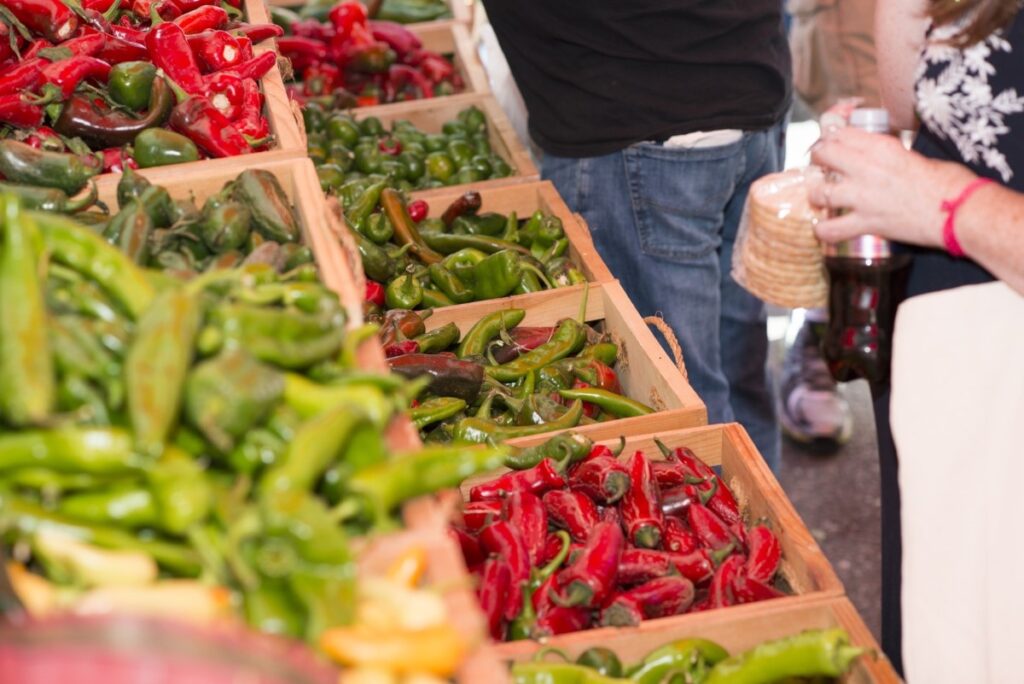The 2023 version of Pueblo’s big fall jubilee, the Chile and Frijoles Festival, just wrapped up. And by all accounts, it was once again a success, bringing an estimated 150,000 locals and out-of-towners to the city’s historic Union Avenue for three days of celebration. But the ‘chile’ part of the festival—Pueblo’s pride and joy money crop—lost a bit of its luster this year. It might be the ‘Year of the Dragon,’ but not so much for chile—Pueblo chile.
It is way too early to lament the death of Pueblo’s vaunted chile crop. But it’s also safe to say that this spicy, little fruit—yes, it’s a fruit—has caught a ‘sniffle.’ This year’s yield is down, and its price is up. Still, while prices have climbed—as much as five dollars a bushel—chile lovers are still willing to dig deeper for what they believe they can’t live without. But for growers, that’s only part of the story.

A couple of things have created this spike in pepper prices: labor costs and weather. Too many workers for too little yield. Always a bad combination.
Mauro Farm’s Carla Houghton does not mince words as she dissects the 2023 crop. “This is the most horrible year of any,” said the Pueblo native. Instead of ‘breaking the bank,’ this year’s harvest just broke the heart. Last spring’s planting “did not produce the chile it should have,” she said. The entire county, perhaps an even bigger stretch in the normally fertile Arkansas Valley, took a hit.
Normally, when you ask Pueblo growers what makes their fruits and vegetables among the best, the usual answer is, ‘hot days and cool nights.’ They call it the perfect balance. But this year, ‘perfect,’ like Elvis, ‘left the building.’ And left early.
Houghton said there were too few hot days and cool nights were replaced by cold ones. The out-of-kilter weather pattern did a job on the crop—and not just chile. “We grow pumpkins, cabbage, tomatoes, eggplant, corn and watermelon,” Houghton said listing her crop inventory. “It’s all been affected.” Beside the expected daytime heat that failed to arrive, hail or “ice coming out of the sky,” as Houghton describes it, also did its part in the downturn. Then, there was rain or, in this case, too much rain, she explained, and when it wasn’t raining, there was cloud cover.
“Farmers that grow vegetables do not want excessive rain.” Growers like her, she said, are happy with rain and snow in the mountains. Pueblo growers are happy with the runoff that fills the reservoir and rivers. Ranchers, she clarified, are the ones who want the rain.
Those who pray for rain in southern Colorado got what they wanted. Others, especially the county’s farmers, got something else. The excessive rains infected Houghton’s fields with fungus, retarding plant growth and rotting countless rows of crops that should have been harvested and sold.
The labor that should have stayed busy, but didn’t, just added to Houghton’s and so many like her’s bottom line. But there was something else that came with the imperfect harvest.
A few Pueblo growers have also gotten something they weren’t expecting from customers, anger with the rise in prices along with the slimmer offerings caused by the weather. One grower who asked to remain anonymous said customers are upset, even rude. “Personally, I’ve gotten such backlash from rude customers not understanding how plants grow.” More than a few visitors, they said, complained about the size and selection available this season.
While the ‘harvest of ’23 will go down, in Houghton’s words, as “the most horrible,” it’s not going to discourage her about next year. Farmers like her appreciate bumper crops and accept down years. It’s just farming. She’ll plant again next season. But for now, there’re still crops that need to be harvested and that’ll continue for a few more weeks. And then, there’s Mauro Farms store, the operation that’s been a staple in Pueblo County for generations.
“We’re a farm and bakery,” she explained. They sell the produce from the farm along with a bevy of other offerings, including spices, salsa, pickles, salami and cheeses, chili brittle and jalapeῆo brittle, frozen chile, zucchini and a Pueblo specialty, potica (pronounced ‘po-teets-uh’).
Potica is sold year-round but is most popular around the holidays. It’s a European dessert made with walnuts, honey, butter, lemon or orange zest and eggs. There are several variations.
Houghton said despite the less-than-ideal harvest, she’ll stay busy shipping both her farm’s chile and the store’s other products, especially to expatriate Puebloans who—no matter where they go—still want their home-town chile. For more information on what’s available, Visit MauroFarm.com. Or if you want to take a drive to Pueblo, the store is located at 836 36th Lane.




